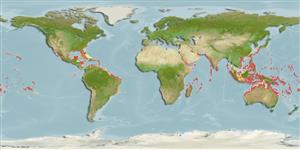Holothuroidea |
Holothuriida |
Holothuriidae
Environment: milieu / climate zone / εύρος βάθους / distribution range
Οικολογία
; εύρος βάθους 0 - 30 m (Αναφ. 107215). Tropical
Indo-Pacific and Western Central Atlantic.
Length at first maturity / Μέγεθος / Weight / Age
Γεννητική Ωρίμανση: Lm ? range ? - ? cm Max length : 41.6 cm TL αρσενικό/απροσδιόριστο; (Αναφ. 119316); μεγ. δημοσιευμένο βάρος: 375.00 g (Αναφ. 119316)
Depth range based on Belize from Ref. 86832. Burrows in sand and is often associated with seagrass beds (Ref. 85218). This is a highly burrowing form. A fish is known to live inside the body (Ref. 118). Caribbean specimens eject Cuvierian tubules when disturbed (Ref. 85218). Deposit feeder (Ref. 833).
Life cycle and mating behavior
Γεννητική Ωρίμανση | Αναπαραγωγή | Γεννοβολία | Eggs | Γονιμότητα | Larvae
Members of the class Holothuroidea are gonochoric and have only one gonad. Spawning and fertilization are both external and some exhibit brooding. Life cycle: Embryos develop into planktotrophic larvae (auricularia) then into doliolaria (barrel-shaped stage) which later metamorphose into juvenile sea cucumbers.
James, D.B. 2001 Twenty sea cucumbers from seas around India. Naga, ICLARM Q. 24(1-2):4-8. (Αναφ. 118)
IUCN Red List Status
(Αναφ. 130435: Version 2025-1)
CITES status (Αναφ. 108899)
Not Evaluated
Not Evaluated
Threat to humans
Human uses
| FishSource |
Εργαλεία
Περισσότερες πληροφορίες
Τροφική ΟικολογίαFood items (preys)
Σύσταση δίαιτας
Κατανάλωση τροφής
Θηρευτές
Life cycleΑναπαραγωγήΓεννητική ΩρίμανσηΓονιμότηταΓεννοβολίαEggsEgg developmentLarvae PhysiologyΚατανάλωση οξυγόνου
Human RelatedStamps, coins, misc.
Διαδικτυακές πηγές
Estimates based on models
Preferred temperature
(Ref.
115969): 25.2 - 29.2, mean 28 (based on 4333 cells).
Ελαστικότητα
Υψηλό, ελάχιστος χρόνος για διπλασιασμό πληθυσμού < 15 μήνες (K=0.7).
Fishing Vulnerability
Low to moderate vulnerability (26 of 100).
Price category
Unknown.
